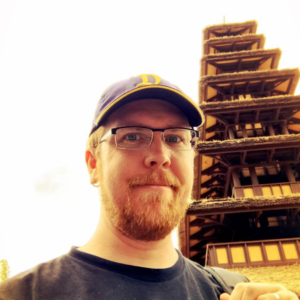I got my BA from Gustavus in 1998 with an individualized major of Computer Animation & Digital Art. This major combined courses from MCS, Fine Arts, and Creative Writing. I’m thankful that Gustavus allowed me to (with faculty input) define this major as a way to follow my passion for the intersection of creativity and computers. I later went on to get an AS in Computer Animation with hands-on software training from Academy College in Minneapolis in 2000.
I am currently working at Pixel Farm in Minneapolis as a Technical Director/CG Animator, where I’ve been for 14 years. At Pixel Farm, I have overseen and collaborated on a wide range of interactive development projects for CDROM, Web, eLearning, mobile apps, games and interactive installations. More recently I’ve expanded my role to serve as a 3D generalist who models, textures and animates things using apps like Maya and After Effects to generate CG assets and animation for things like TV commercials, museum installations, and corporate communications. In addition to rendering and compositing CG image sequences, I’ve been working with a team that is exploring more and more uses for realtime game engines like Unity3D to build VR experiences for the Oculus Rift and HTC Vive. It’s been exciting to see how low poly modeling and powerful new hardware can bring us a whole new way to experience and consume CG graphics from inside the VR headset, not just looking at the 2D plane of a monitor screen.
My wife, Kira (Showalter) Weier graduated from GAC in ’98 as well, with a French major. She has since gone on to get a Masters in Nursing and works as a Certified Nurse Midwife. We have two sons. My hobbies include disc golf, complex tiki drinks, and studying theme park attraction design/history.
How did the MCS department help you get where you are today?
Dr. Stephen Hilding’s courses in Calculus I & II gave me my first taste of using software (Mathematica) to visualize mathematics in 3D. Dr. Karl Knight was one of my advisers and my professor for Intro to Comp Sci. He guided me to use MIT Scheme to learn core concepts of programming logic that I have since applied in a number of languages when scripting visual solutions using ActionScript, Javascript, and MEL. Dr. Mike Hvidsten’s Special Topics course in Computer Graphics exposed me to concepts of 3D code-driven modeling, animation and ray tracing. Mike’s course, along with Karl’s mentorship and an independent study course on Java for 2D graphics, were some of the first steps I took on my journey into a career that is now mostly 3D CG graphics and animation. As a side note, Dr. Jeff Rosoff’s course in Linear Algebra taught me why I prefer to leave matrix transformations and quaternion calculations for the computers to deal with.
What is your favorite memory or memories of the MCS department?
I think the most rewarding memory was when, in Mike’s Computer Graphics class, our group built a CG car out of geometric primitives using OpenGL, and then created keyboard handlers to drive it around in 3D. There was also a brief traveling VR demo called “Dactyl Nightmare” that visited back at GAC in the late 90’s. That which was my first exposure to (then extremely basic and clunky) VR. I was reminded of these events recently at my work as we continue work on a fully 3D modeled & textured car that can drive around in VR using Unity3D and steering wheel/pedal input handlers.
What’s changed the most since graduating?
My industry is constantly building on the shoulders of its predecessors, and I don’t have to code as much as I used to. Now my world is filled with pre-coded tools like motion graphs, keyframed object attributes, UV editors, parametric mesh networks and physics simulators. However, OpenGL and matrix transformations are still there behind the scenes, crunching away on increasingly powerful GPU’s and CPU’s, thanks to computer scientists and engineers who continue pushing the boundaries on behalf of computer artists.
The cost of processing power, memory and storage has dropped exponentially since 1998 and brought power well beyond the supercomputers of those days into the hands of graphics professionals and even mobile devices. My senior year of Gustavus, I had a (then somewhat powerful) 250Mhz 604e processor, 2GB Hard Drive and 128MB of RAM. Fast forward 20 years and I recently purchased a PC for $1000 less which has quad-core 4Mbps CPUs, 32GB of RAM, an nVidia gtx 1080 GPU, and a 2TB hard drive. Back then, even the most basic 640×480 8-bit ray tracing of reflective and refractive surfaces was painfully slow on GAC’s SGI Indy’s in the computer lab. Now, at work, I can queue up Muster to render entire sequences of 1920×1080 (or much higher resolution) 32-bit images on a 100TB storage area network using a Vray render farm of 24-CPU machines. Today, we can often grind out hundreds of 4K multi-pass EXR frames in not much longer time than I was able to render a single 640×480 ray traced bitmap 20 years ago.
I’m fascinated to imagine where things will be another 20 years from now.
Anything else you would like to add or mention?
I just wanted to give everyone an update and say thanks to the MCS department at Gustavus for helping to send me down this path so long ago. I might not be working for Disney or Pixar but I’ve found a rewarding career in computer graphics thanks in large part to the support I received from Mike, Karl, and others.
For some examples of our work at Pixel Farm in Minneapolis, check out the CG section of our website: http://www.pixelfarm.com/reels/animation-motion-design/ Here’s more about our VR department: http://www.pixelfarm.com/vr-2/
Matt will be coming to Gustavus to give a presentation on the evolution of computing in the creative and entertainment industries on October 16th at 3:30 PM. Keep an eye on the blog and the events calendar for details.
If you would like to let the MCS department know what you are up to you can do so by clicking here. We would love to hear from you.


